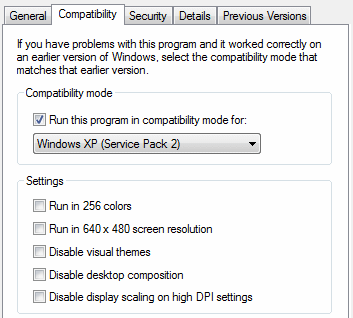
Fortunately, many applications still work fine under Windows Vista. However, there are some applications which compatible with Windows Vista because they are not able to handle the changes in Windows Vista compared to Windows XP. User Account Control is one of those changes to offer a better secured operating system. Sometimes, this problem is solved by (temporarily) disabling User Account Control (which can be done at the item User Accounts in the Control Panel). But for security reasons, deactivating UAC is not advised!
Does an application not function properly or does it show an error message every time it is used, try to run it with additional administrator rights! By default, an application is not started with those additional rights, but this can be done manually by right clicking (the shortcut to) the application and to select Run as administrator. Those administrator rights can also be added by default by right clicking the shortcut to the application and to select Properties, tab Shortcut, button Advanced and to activate the option Run as administrator.
Limited permissions
The issues concerning the limited permissions is related to the problem with
the administrator rights.
Without the permission to modify files in a certain location, an application is
not able to save a file in this folder (as example, it is not possible to change
or add files in the
C:\Program Files without the permissions to do it). In most cases this
problem can be solved by running an application with additional administrator
rights. A better alternative is adding permissions to modify the concerning
folder. This is done by right clicking the folder and to chose for Properties, tab
Security, button Edit (or
the button Advanced) and
to activate the option Full control for the concerning user account.
Virtual Store: virtualization of files
In Windows Vista, many folders are secured, which makes it impossible for an
application to make changes to the files in the folders. For example, the folder
C:\Program Files
is secured: only an application with additional administrator rights is able to
modify the files! However, many older applications continuously try to store
files in this folder, which should not be placed there. To solve this issue, Windows Vista
uses virtualization of files (which are stored in the Virtual Store). The
application is not aware of this virtualization, and thinks the files are stored
on the prescribed location. Virtualization is done separately for every user
account, the files are stored in
C:\Users\loginname\AppData\Local\VirtualStore. Program Files
is one of the folders in the Virtual Store, which contains the user
specific settings for the applications. All users must change the settings of
the virtualized applications separately. This is an advantage as well because
the changes won't affect the other users.
|
|
DISABLING THE VIRTUALIZATIONBecause of the virtualization, files are stored on multiple locations (every user account has its own virtualization folder), which makes it hard to handle them (the incoming folder of the file sharing software eMule is a good example). Is the virtualization unwanted because the files (and settings) have to be applied to all user accounts? This can be realized by giving all user accounts permissions to fully control all the files in the folder which else will be virtualized. Right click the folder and select Properties, tab Security, select Users and set the permissions to Full Control. If this procedure is too much work, the application can be run as administrator as well. This is done automatically by right clicking the shortcut and to chose for Properties, tab Shortcut, button Advanced. |
Windows Vista manages the running of programs differently compared to previous Windows editions, which can result in compatibility issues for older software. Some of the compatibility issues are solved by running a program in the Windows XP compatibility mode. This is done with the tab Compatibility of the program shortcut Properties (available by right clicking the shortcut). The compatibility mode pretends the program it is running in an earlier Windows edition. Unfortunately, it is not always a solution to compatibility problems.

TIP: If an older program is still not functioning as it should be, a virtual environment of a previous Windows edition can be a definitive solution to the problem. Therefore, Microsoft's has created the tool Virtual PC (download: www.microsoft.com). This software virtualizes a whole new computer on which a previous Windows version can be installed.
Although there are compatibility issues, there are many programs which work properly (with or without additional permissions) within Windows Vista. Microsoft investigated many programs and made a list of Windows Vista-compatible software which is divided in two categories: the software is certified for Vista or the software works with Vista. When the software is tested by Microsoft and placed in one of those categories, the vendor is allowed to label the software with the logo Certified for Windows Vista or Works with Windows Vista. The page www.iexbeta.com gives a useful summation of (almost) Windows Vista compatible software. The combination of these sources must be sufficient to tell whether a program will work properly within Windows Vista.
© 2001-2022 - Menno Schoone - SchoonePC - Rotterdam - The Netherlands